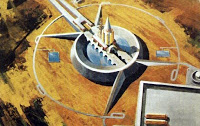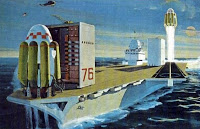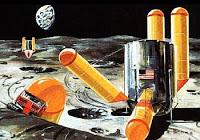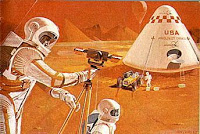Back in 1964, Phil Bono of Douglas Aircraft (which later merged to become McDonnell Douglas) came up with a bold proposal for a reusable single-stage booster. The Reusable Orbital Module, Booster, and Utility Shuttle (ROMBUS) consisted of a large central core rocket surrounded by eight disposable hydrogen fuel cells (that would drop to earth by parachute and thus be themselves reusable). It would have had a payload of 990,000 lbs. (compare to the 52,600 maximum payload the Space Shuttle could bring to LEO) and have cost $195 per pound in 2010 dollars (compare to the Space Shuttle, which ended up costing around $9,000 per pound). The Rombus would have been recoverable at sea.
But the best part about the Rombus design, efficient and innovative as it was at the time, were the spin-off projects that were built around the basic design.
Ithacus was designed using the basic concept of Rombus, but as an intercontinental troop carrier capable of transporting 1,200 troops with full combat gear anywhere in the world in 90 minutes. Yes, that’s right. A drop-ship design from 1964. There was also an Ithacus Jr. that would be able to transport 260 soldiers or 33.5 tons of materiel. They would be launched in pairs from nuclear-powered aircraft carriers to deploy troops and equipment. Pegasus was a civilian version of the concept.
Bono figured out that, if there was a capacity for refueling the rocket in Earth orbit, one of his Rombus ships could make it to the moon and back. That realization was the basis for Project Selena, which would have had a permanently manned lunar base with a crew of 25 by 1978, and a thousand-man base producing rocket fuel from the lunar regolith by 1984 (damnit, that’s what SHOULD have been happening when I was graduating from high school!). The base itself would be constructed out of spent fuel canisters, which would be brought to the moon as shelter material rather than discarded once the hydrogen fuel was spent.
Project Deimos was similar in concept, although grander in scope; a Rombus vehicle could take a Mars Excursion Module on a 200-day journey in 1986. The expedition would remain on the surface for 20 days and then return. Later expeditions would have a much longer staying-time, owing to unmanned Rombus vehicles which would drop off supplies for future manned exploration missions.
Alas, the Rombus never got past the design stage and multiple-stage rockets won out over SSTO’s (with more work the overly-optimistic estimates of capacity and cost would probably have been made more realistic), and we got the space program of Apollo, Skylab, the Space Shuttle, and the ISS. Which are spectacular achievements in and of themselves of course, but it does make me long for a manned lunar colony and men on Mars…
All images in this post credit: NASA.













What makes a generation of elites give up on space and squabble over Earth's finite resources? Easy money for contracted projects that don't work, I'd say. We're just grafting electronics and carbon fiber to Korean War Era machines…
Awesome. This really makes me want to start up a sci-fi campaign based on this alternate history and the idea that we encountered underground martian civilizations when the manned Mars expeditions began. That it could be set in the past is really fascinating to me.
As Carl said, this really makes you wnat to bust out the Alternity or Thousand Sun books and start up a campaign based on the idea that humanity didn't muck up preliminary space exploration.
How did he solve the radiation problem for getting a crew to Mars and back alive?
Man, I remember seeing the Rombus artwork when I was a kid. It's pretty awesome (and a touch disheartening) to see how ambitious the project was, and what we ended up with.
Thanks for sharing this, though. Those Rombus illustrations kept me drawing landers and all sorts of ships based on the same design for years.
I have all three of the books, the third being an updated and revised edition of the first. I actually got the first Bono book as a school prize (I got to choose a book I wanted). Awesome stuff.